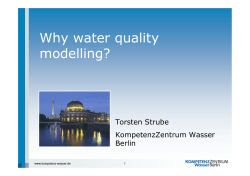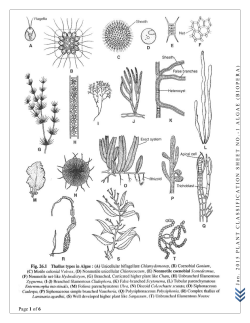
Cybernetic mechanisms in lake plankton systems: how to control undersirable algae
(Reprinted from Nature, Vol. 273, No. 5659. pp. 228-230, May 18,1978) @ Macmillan Journals Ltd., 1978 Cybernetic mechanisms in lake plankton systems: how to control undersirable algae ., TOXIC algal blooms represent a serious nuisance in lakes and ponds. Not only do they form floating scums and impart odours and tastes to the water, but they are also associated with the occurrence of dermatitis in our own species and fatal poisoning in livestock. To reduce algal levels, man resorts to various practices that range from chemical 'control' to artificial mixing of the lake'. Most of these have deleterious, if not immediately toxic, effects on the other compartments of the system as well. In this report safer alternatives are presented. As toxicity is primarily a defence mechanism evolved against herbivores, the problem of controlIing toxic algae can be transposed to the simpler one of control1ing inedible algae. A simple loop model of a lake plankton community containing an inedible compartment is then sufficient to reveal how the system wil\ respond to perturbations introduced at different trophic levels. This, in turn, suggests various ways to achieve biological control of the inedible (undesirable) species. The model considered (Fig. la) is a simplified planktonic food web reduced to six variables: nutrients (N), inedible algae (AI), edible algae (A2), herbivores (H), carnivores (C) and planktivorous predators (P). The distinction between edible and inedible algae is based on the overwhelming evidence2-s that phytoplankton celIs are selected on the basis of size, taste and morphology. Here the term 'inedible' is used realistically: we recognise the likelihood of some members of group Al being occasionalIy ingested by grazers but consider these instances truly exceptional in a community in which 'edible' algae are also present. Accordingly, throughout this report Al refers to an heterogeneous group of species including alI blue-green algae, irrespective of size, plus all other phytoplankton species larger than 50 /.Lm, but excluding the common diatom Asterionella formosa. As the latter is easily broken down and ingested"'s it was integrated in A2. Blue-greens excepted, alI algae smalIer than 50 /.Lm were considered edible. The few taxa possessing an ambiguous trophic status were excluded from either group. This applied to the gelatinous greens Sphaerocystis schroeteri and Elakatothrix gelatinosa that may be enhanced by grazers', the colonial diatoms Fragilaria and Tabellaria that can be ingested by cope pods when fragmented (K. Porte.r, personal communication) and the colonial chrysomonad Dinobryon that may be a major food source for daphnids when it is present in high density'.. The dynamics of this planktonic model can be readily explored by loop analysis. This technique recently developed by Levins"'" is particularly applicable to ecological systems in which most interactions among the biological variables can only be specified qualitatively. Loop analysis is based on the equivalence between differential equations near equilibrium and matrices and their loop diagrams. Thus, in our particular system the elements aij of the matrix and the loop diagram (Fig. 1) represent the effect of variable j on the growth of variable i when the equation dXi/dt= f; (Xl, . . . Xj, . . . , Xn) is solved at equilibrium. As all stability require ments are satisfied for our model, one can assess mathematicalIy the consequences on the entire system of changes in each variable. The reader interested in the details of the technique is referred to the formal treatment of loop analysis theory". As shown in Table I, the predictions derived from our model are often far from obvious. For example, increasing predator density (case 6) wil\ leave the herbivore level _oNA) -ONAz 0 0 °A,N 0 0 0 0 0 °AzN 0 0 _0 AzH 0 0 0 0 °H Az 0 0 0 0 °CH 0 0 0 °pH -ONN 0 . _oH _oHP C 0 _ocP 0 ope Fig. 1 a, Loop diagram of the six-variable system. Positive effect of variable i on variable j is indicated by an arrow going from i to j. Negative effect is indicated by a circle. Nutrient resources are not selfreproducing and are thus self-damped. b, Matrix of the system, taking all the au as positive numbers and representing the directions of their effects by the sign in front. unaltered yet increase the inedible algae. Also the addition of herbivores to the system (case 4) has no effect on the standing stock of alI animal consumers. Thus, one cannot infer the response of one variable to changes in another from the simple knowledge of the direct link between the Table 1 Predicted response of plankton systems to perturbations in each variable PerturbaCase tion* Effect on the level of N +N 0 Predictions A, A. H C P + 0 0 0 0 supported by Fertilisation experievidenc ments and e from 'cultural' eutrophication (refs 16-18) - 0 2 3 +A, +A. 0 0 0 0 4 +H 0 5 +c 0 + - 0 - + 0 6 +p 0 + - + 0 + - + (Currently being tes ted 0 O in long-range experi- 0 + J ments in situ) - o Lake manipulations (ref. 21) two. Clearly the structure of the entire network needs to be taken into account, as its effects may regularly overpower simple-link effects. This is where the power of loop analysis lies and why it often yields unexpected results"''', especially when there is no direct link between the two variables considered. For instance we can predict in this manner that adding inedible algae to our system (case 2) will increase the carnivore level but will reduce the standing stock of the other animal consumers. As the evolution of inedibility in algae leads to the development of toxicity that is considered undesirable by man, we can treat AI as the variable to be reduced. According to our model, this can be achieved in four ways (see column AI in Table 1): that is, either by reducing the rate of nutrient supply, by increasing carnivore levels or by reducing predator or herbivore stocks. The first method is particularly applicable when there is a point discharge of nutrients into the water body: this was demonstrated spectacularly by the diversion of sewage from Lake Washington". Unfortunately nutrient inputs are not controllable in most cases. Biological manipulation of lake communities may then well represent the only means for selective algal control. Although this approach has been convincingly advocated by Shapiro et aI." it has remained surprisingly neglected. The results of our work suggest simple ways to achieve biological control of undesirable algae. Among these, the introduction of herbivore-specific disease or the addition of primary carnivores would seem particularly worth trying. It is clear that the table of predictions generated by our model would take years to be tested in its entirety. Its general validity, however, is supported by long-term field experiments and indirect evidence from previously published work. A particularly well documented case, because of the great concern for the consequences of artificial eutrophication, is that of nutrient addition. We predict here (case 1), in agreement with previous models of nutrient enrichment".'..17, that the increment in nutrients is picked up entirely by the inedible algae. Evidence from 'cultural' eutrophication".l8 and fertilisation experiments" supports our contention. The common response of lakes to nutrient enrichment is an immediate increase in the density of the algae considered inedible and a change in the qualitative composition, but not in the standing stock, of the consumer levels. Further, as N itself remains unaltered, it can be understood why nutrient levels are poor indicators of eutrophication". Conversely, we predict that a decrease in the rate of nutrient input (case 7) will reduce only the level of inedible algae without altering those of N, A2, H, P or C. This would indicate, as already pointed out by Phillips'. for marine systems, that inedible algae serve as a buffer against variations in the nutrient supply. This hypothesis was tested by following from June to November 1976 the effects on lake plankton of cutting the nutrient input from the sediments. The communities studied were enclosed in a series of polyethylene tubes, each 1 m in diameter and 10 m deep, suspended in Heney Lake, a lake with low levels of nutrients 60 miles north of Ottawa. Community structure was monitored by weekly sampling at 0, 3, 6 and 9 m, followed by microscopic enumeration using the sedimentation technique of Utermohl21. Our predictions (case 7) were all confirmed. Comparing tubes open at both ends and sunk in the sediments with tubes sealed at the bottom revealed that their population stocks were similar at each trophic level throughout the 5-month study. (Wilcoxon matchedpairs signed-ranks test) except for the inedible algae that were significantly reduced (P<0..o25) in the latter case. In light of this 'enclosure effect' and of the increasing popularity of this technique among aquatic ecologists, the use of tubes in contact with the sediments is recommended as the closest simulation of lake conditions. Support for our predictions concerning the response of planktonic communities to changes in predation levels (cases 6 and 9) is found in the classic investigations by Hrbacek".23. He documented a shift from nannoplankton to netplankton and a change in the species composition but not in the standing crop of the herbivores after increases in stocks of planktivorous fish. Then, by eliminating fish stocks altogether he was further able to induce a shift from netplankton to nannoplankton. More recently Smyly" detected no noticeable change in herbivore levels following the reduction in fish predation in experimental enclosures. The response of plankton systems to reduction in both herbivore and carnivore levels in polyethylene tubes at Heney Lake was also investigated. All components of the planktonic community were represented in our experimental enclosures, including, in addition to 99 phytoplankton species, herbivores such as Bosmina, Chydorus, Daphnia and Diaptomus, the primary carnivores Epischura and Mesocyc!ops, and the predators Chaoborus and Leptodora. Throughout the 5-month study Hand C levels were reduced each week by passing a net of 0.75 m in diameter and 135 JIm mesh aperture through the tubes. Examination of tl1e loop diagram (Fig. 1) shows that the net outcome of decreasing jointly Hand C levels is to reduce the carnivore population alone, because of the negative CH loop. The consequent predictions (case 8) were generally verified by our experiments. Using unperturbed enclosures for comparison, we found that the manipulations resulted in a significant increase (P<O.025) in the biomass of inedible algae and in no significant changes in herbivore and carnivore levels (Wilcoxon test). The only discrepancy was that no significant decrease in edible algae was recorded. We thank R. Trucco and D. Wall for field assistapce, and R. Levins, J. R. Strickler and P. Yodzis for discussions. This work was supported by the National Research Council of Canada in the form of a grant to F. B. and a predoctoral scholarship to E. M. FREDERIC BRIAND EDWARD MCCAULEY Department of Biology, University of Ottawa, Ottawa, Canada KIN 6N5 Received 14 February; accepted 20 March 1978. 1. Dunst, R. C. e/ al. Survey of Lake Rehabilitation Techniques and Experiences (Tech. Bull. No. 75, Dept Nat. Resources. Madison. Wisconsin, 1974). 2. Burns. C. Limnol. Oceanogr. 13, 675-678 (1968); Int. Rev. Ges. Hydrobiol. 53, 83-100 (1968). 3. Gliwicz. M. Bull. A cad. Polon. Sci.. CI. II, 17, 159-165 (1969); Verh.Int. Verein. Limnol. 19, 1490-1497 (1975). 4. Arnold. D. E. Limnol. Oceanogr. 16,906-920 (1971). 5. Weers, Eo T. & Zaret. T. M. Verh. Int. Verein. Limnol. 19, 1480-1483 (1975). 6. Porter, K. G. Nature 244,179-180 (1973). 7. Porter, K. G. Am. Sci. 65, 159-170 (1977). 8. Nadin-Hurley. C. M. & Duncan. A. Freshwater BioI. 6, 109-123 (1976). 9. Porter. K. G. Verh. Int. Verein. Limnol. 19, 2840-2850 (1975); Science 192, 1332-1334 (1976). 10. Tappa. D. W. Ecol. Monogr. 35, 395-423 (1965). 11. Levins, R. Ann. N. Y. Acad. Sci. 231, 123-138 (1974). 12. Levins, R. in Ecology and E,'olution of Communities (eds Cody, M. & Diamond, J.) 16-50 (Harvard University Press, Cambridge, Massachusetts, 1975). 13. Lane, P. & Levins, R. Limnol. Oceanogr. 22, 454-471 (1977). 14. Edmonson, W. T. in Nutrients and Eutrophication (ed. Likens, G. E.) 172-193 (Am. Soc. Limnol. Oceanogr. Special Symposium, 1972). 15. Shapiro. J., Lamarra. V. & Lynch, M. in Water Quality Management Through Biological Control (eds Brezonic, P. L. & Fox, J. L.) 85-96 (Report No. ENV.-07-75-1, University of Florida, Gainesville, 1975). 16. Phillips. O. M. Arch. Hydrobiol. 73, 310-333 (1974). 17. Smith, F. E. in Eutrophication: Causes, CQnsequences,'''Correctil'es 631-645 (National Academy of Sciences. Washington, DC, 1969). 18. Larkin, P. A. & Northcote, T. G. in Eutrophication: Causes, Consequences, Corredives 256-273 (National Academy of Sciences, Washington, DC, 1969). 19. Schindler, D. W., Armstrong, J., Holmgren, S. K. & Brunskill, G.J. J. Fish. Res. Bd. Can. 28,1763-1782 (1971). 20. Hooper, F. F. in Eutrophication: Causes, Contequences, Correctives 225-235 (National Academy of Sciences, Washington. DC, 1969). 21. Utermohl, H. Arch. Hydrobiol. Plankt. 22, 643-645 (1931). 22. Hrbacek, J. Rozpravy Ceskosl. Akad. Ved, Rada Matem. 72, 1-114 (1962). 23. Hrbacek. J. & Novatna-Dvorakova Rozpravy Ceskosl. Akad. Ved, Rada Matem. 75, 1-64 (1965). 24. Smyly, W. J. P. Freshwater Bioi. 6, 241-251 (1976). Printed in Great Britain by Henry ling ltd., at the Dorset Press, Dorchester, Dorset
© Copyright 2025





















